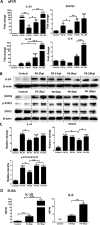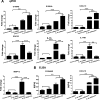IL-24 Promotes Pseudomonas aeruginosa Keratitis in C57BL/6 Mouse Corneas
- PMID: 28330899
- PMCID: PMC5440843
- DOI: 10.4049/jimmunol.1602087
IL-24 Promotes Pseudomonas aeruginosa Keratitis in C57BL/6 Mouse Corneas
Abstract
The aim of this study was to elucidate the expression and functions of IL-24 in C57BL/6 mouse corneas in response to Pseudomonas aeruginosa infection. Among IL-20R cytokines, only IL-24 was induced at both mRNA and protein levels by infection at early time points. The upregulation of IL-24 was dampened by flagellin pretreatment, which protects the corneas from microbial infection. Time course studies revealed bimodal early and later peaks of IL-24 expression, a pattern shared with suppressor of cytokine signaling (SOCS)3 but not IL-1β or IL-6. Silencing of IL-24 enhanced S100A8/A9 expression and suppressed SOCS3, IL-1β, IL-1RN, and matrix metalloproteinase 13 expression at 6 h postinfection. Downregulation of the IL-24 signaling pathway significantly reduced the severity of keratitis, whereas rIL-24 exacerbated P. aeruginosa-mediated tissue destruction. In vitro, rIL-1β induced the expression of SOCS3, IL-24, IL-1β, and IL-6 in primary cultured human corneal epithelial cells. rIL-24, alternatively, stimulated the expression of SOCS3, but not the others. In conclusion, IL-24 promotes P. aeruginosa keratitis through the suppression of early protective mucosal immunity, culminating in increased severity of P. aeruginosa keratitis.
Copyright © 2017 by The American Association of Immunologists, Inc.
Figures









Similar articles
-
IL-17 Promotes Pseudomonas aeruginosa Keratitis in C57BL/6 Mouse Corneas.J Immunol. 2020 Jan 1;204(1):169-179. doi: 10.4049/jimmunol.1900736. Epub 2019 Nov 25. J Immunol. 2020. PMID: 31767781 Free PMC article.
-
Opposing Effects of IL-1Ra and IL-36Ra on Innate Immune Response to Pseudomonas aeruginosa Infection in C57BL/6 Mouse Corneas.J Immunol. 2018 Jul 15;201(2):688-699. doi: 10.4049/jimmunol.1800046. Epub 2018 Jun 11. J Immunol. 2018. PMID: 29891552 Free PMC article.
-
TSLP Protects Corneas From Pseudomonas aeruginosa Infection by Regulating Dendritic Cells and IL-23-IL-17 Pathway.Invest Ophthalmol Vis Sci. 2018 Aug 1;59(10):4228-4237. doi: 10.1167/iovs.18-24672. Invest Ophthalmol Vis Sci. 2018. PMID: 30128494 Free PMC article.
-
Role of innate and adaptive immunity in the pathogenesis of keratitis.Ocul Immunol Inflamm. 2005 Apr-Jun;13(2-3):133-8. doi: 10.1080/09273940490912362. Ocul Immunol Inflamm. 2005. PMID: 16019672 Review.
-
Corneal response to Pseudomonas aeruginosa infection.Prog Retin Eye Res. 2004 Jan;23(1):1-30. doi: 10.1016/j.preteyeres.2003.10.002. Prog Retin Eye Res. 2004. PMID: 14766315 Review.
Cited by
-
IL-17 Promotes Pseudomonas aeruginosa Keratitis in C57BL/6 Mouse Corneas.J Immunol. 2020 Jan 1;204(1):169-179. doi: 10.4049/jimmunol.1900736. Epub 2019 Nov 25. J Immunol. 2020. PMID: 31767781 Free PMC article.
-
Association of Single-Nucleotide Polymorphisms in Interleukin Genes with Microbial Keratitis in a South Indian Population.Pathogens. 2022 Nov 20;11(11):1387. doi: 10.3390/pathogens11111387. Pathogens. 2022. PMID: 36422638 Free PMC article.
-
Ocular Surface Infection Mediated Molecular Stress Responses: A Review.Int J Mol Sci. 2022 Mar 14;23(6):3111. doi: 10.3390/ijms23063111. Int J Mol Sci. 2022. PMID: 35328532 Free PMC article. Review.
-
IL-36α Enhances Host Defense against Pseudomonas aeruginosa Keratitis in C57BL/6 Mouse Corneas.J Immunol. 2021 Dec 1;207(11):2868-2877. doi: 10.4049/jimmunol.2001246. Epub 2021 Oct 22. J Immunol. 2021. PMID: 34686582 Free PMC article.
-
Opposing Effects of IL-1Ra and IL-36Ra on Innate Immune Response to Pseudomonas aeruginosa Infection in C57BL/6 Mouse Corneas.J Immunol. 2018 Jul 15;201(2):688-699. doi: 10.4049/jimmunol.1800046. Epub 2018 Jun 11. J Immunol. 2018. PMID: 29891552 Free PMC article.
References
-
- Molina DN, Colon M, Bermudez RH, Ramirez-Ronda CH. Unusual presentation of Pseudomonas aeruginosa infections: a review. Boletin de la Asociacion Medica de Puerto Rico. 1991;83:160–163. - PubMed
-
- Willcox MD. Pseudomonas aeruginosa infection and inflammation during contact lens wear: a review. Optometry and vision science: official publication of the American Academy of Optometry. 2007;84:273–278. - PubMed
-
- Hashimoto C, Hudson KL, Anderson KV. The Toll gene of Drosophila, required for dorsal-ventral embryonic polarity, appears to encode a transmembrane protein. Cell. 1988;52:269–279. - PubMed
MeSH terms
Substances
Grants and funding
LinkOut - more resources
Full Text Sources
Other Literature Sources
Molecular Biology Databases

